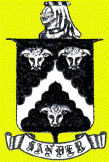

Until October 1944 I was assigned various duties in Algiers, Oran and Tunis, all involving liaison with the French. Many experiences were enlightening, including bombardment by Stukas in Algiers, a minor role in the capture of a Spanish spy in Oran, and learning to fence with the epée in Tunis. The arrival of De Gaulle in Tunis on his way to London via Algiers was a significant event that improved my relations with the people I dealt with. But after the Allied invasion of Sicily time hung heavy. In October I sailed from Algiers to Naples on the Ville d'Oran. During the trip by truck to Rome I saw at first hand the devastation of all-out war.
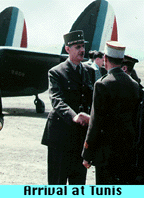
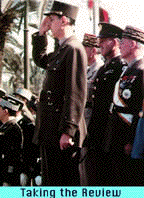

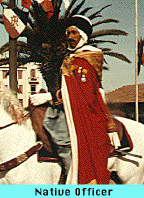
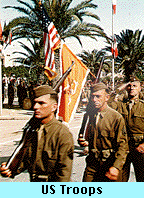
|
I was fortunate to be present in Tunis unattached to any unit. Consequently I was able to be present at the welcoming ceremonies for General De Gaulle and to photograph the review in his honor. American troops participated in the march-past but their uniforms were outshown by those of the French colonial troops. Both the mounted men, a Captain and a maréchal des Logis, (sergeant) are Spahis. (native cavalry) In the photo of De Gaulle at the salute the American officer behind him is a three-star general. Someone among you may be able to identify him.
After three days in Rome during which I explored St Peter's from top to bottom I jeeped to the airport and boarded an A-26 attack bomber. I stood behind the navigator's seat, then occupied by a general, my head in the plexiglass astrodome. From this vantage point I could see in all directions. After a refueling stop at Bastia in Corsica, we flew north to Lyon, but too low and too close to the Alps for my peace of mind. Several weeks in just-liberated Lyon ended suddenly with an order to go to Paris. Three of the nineteen hours that I stood (the train was chock-a-block) were at a halt in blackout just outside the city, then under air attack. Wartime Paris was gai once more, for it was free again. Its citoyens welcomed the liberators of all nations, although many were still hungry and cold.
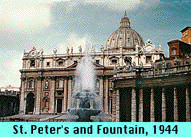
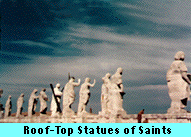
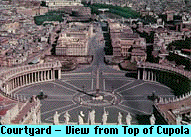
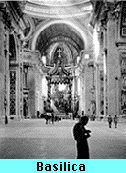
|
My work involved the Allied supervision of all information disseminated by French media regarding Allied activities and movements. In addition, nothing derogatory regarding leadership or conduct would be permitted. Working with a staff of officers posted in the twenty-seven larger départements of France, I had priority telephone communication with them from my office at 2 Place de l'Opéra. Only once did I fail in my task. One morning in December 1944 the man who was presenting the program of morning exercises on the RadioDiffusion Nationale said, (in French)"Don't open your window this morning. It's foggy outside." The officer on duty at the studio on the Champs Elysées had no way of stopping this ad lib that may have given the Germans a precious bit of information: It was foggy - so Allied planes couldn't fly and the Ardennes offensive could be launched without interference from the air. That remark almost cost me my job. Only the fact that it was not in a script saved me.
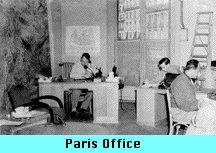
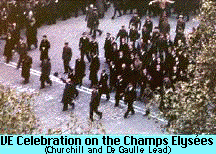
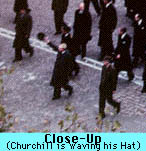
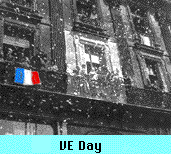
|
French censorship was one floor above. Five of the staff of seven were women, whom I invited to dine at the officer's mess of the Chatham hotel. All five, one at a time, were glad to wolf down peanut butter and jelly in a well-heated dining room where the French chef's ingenuity made even the ubiquitous Spam stay palatable. One of them, Georgette Cordin, was to become my wife. I took the photo of the parade on the Champs Elysées from the sixth floor balcony of the Radiodiffusion nationale. The roof tops were lined with armed French soldiers. Well-disciplined Communists grouped at the entrance to the Avenue George Cinq were shouting in unison, "Chursh-heel","Chursh-heel".The right-hand photo was taken by a French newspaperman who distributed large prints to all and sundry. I have highlighted the balcony of the office where we were all engaged in throwing torn up paper in lieu of confetti while the diminutive opera singer Lili Pons sang la Marseillaise across the street on the steps of the Opéra.
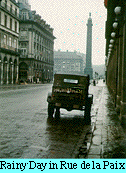
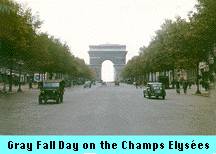
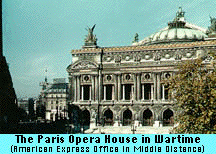
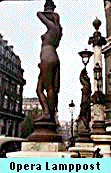
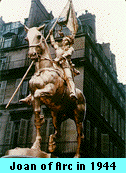
|
Two pictures show the normal traffic in liberated Paris. Most civilians used the Metro or rode bicycles. There are some in the photo. I could stand in the middle of the Champs Elysées with no fear of being run over. I wouldn't try it today. The photo on the left shows the Place Vendôme in the distance with the column made of cannon captured by Napoleon. He stands on top dressed in a toga. I imagine the lampposts at the opera were daring when it was completed in 1875. Jeanne d'Arc was gilded by the Germans during the occupation. I don't think the residents were appreciative. They needed food and heat, not a gesture.
During the ten months I spent in Paris after VE Day, I continued courting and at last, after much army red tape, married Georgette Madeleine Cordin.We agreed that she would henceforth be called Georgia. We wed at four in the afternoon on 3 April 1946 in St. George's chapel of the Church of England on the Avenue George V with only two witnesses to the ceremony performed by a Baptist Army Chaplain. The civil rite that morning was in the Mairie of the 13th Arondissement. An old corpulent Communist in a tail-coat with a red sash draped over his middle, the vice-mayor, stumbled through the prescribed phrases but redeemed himself at the end by saying that he was pleased to have been able to preside over the union of a fair flower of France to a gallant ally, liberator of his country. After a ten-day honeymoon in Nice at the Hotel Negresco. paid for by the army, we returned to Paris to await transportation to the United States.
Less than a month later Georgia was on the S.S. Brazil and I was on a Liberty ship that left on the same day that she had embarked from the war-brides' center: Camp Lucky Strike. The sea was calm during the six-day voyage. As soon as my ship docked I ran to the Brazil, and after convincing a guard that I was an authentic husband, was allowed on board. I found that Georgia had been given an upper berth on a train called the Exposition Flyer. We changed that to a lower, and I kissed her goodbye. That night I was train commander (my low serial number again) en route to Chicago. We ate from mess kits in a baggage car.In the morning at Chicago the troop train sat motionless for several hours and then was shunted around, stopping with a bang. I asked the conductor what had happened. He said that we had been attached to the Exposition Flyer.I ran the length of the troop train (nine sleeping cars) and in the first civilian Pullman there sat Georgia. We were both joyful, for we had thought to be separated for a week. As it turned out we were more than fortunate, for the next afternoon the train stopped at Burlington Iowa, halted by a strike. A newsman took the photo below. That night I moved Georgia, two Red Cross girls and another war bride, all with army movement orders, into the troop train where one car had a number of bedrooms that I put 'Off Limits' The next morning the military cars with some three hundred men and officers moved. The Exposition Flyer remained stationary.
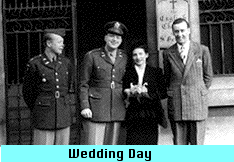
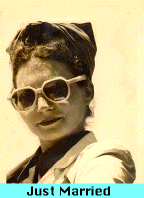
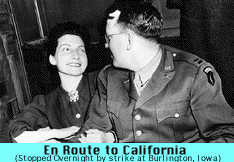
|
The wedding at St. George's Church was attended by Captain Thomas Ringwood, who was one of the officers of my liaison group headed by Major Peter Oustinoff, a cousin of the famous actor-writer of the same name. Rumor has it that Madamoiselle Hennessy of the cognac family looked with favor on Tom. The civilian, Monsieur Olivier Loubeyre, was a good friend for the rest of his life. Agent for a large insurance company, he took care of the litigation and costs arising from the automobile accident discussed and pictured below.The photo of Georgia was taken on our honeymoon in Nice.
Top
Page 1
Page 3
Page 4
Page 5
Page 6